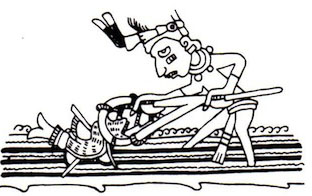
<< Fishing, Borgian Codex
The codex is a 10.3 m ong accordion-fold, consisting of 76 pages on 39 leaves with dimensions of 27 X 26.5 cm.
The Borgia Codex is an ancient book, created in Mexico in the age before the arrival of the Spanish. It consists of 39 double-sided pages, each of which contains pictures and drawings. It was most likely used by native priests to predict cycles of time and fate. The Borgia Codex is considered one of the most important surviving pre-Hispanic documents, both historically and artistically.
The Borgia Codex was created by one of many pre-Hispanic cultures of Central Mexico, likely in the region of southern Puebla or northeastern Oaxaca. These cultures would eventually become vassal states of what we know as the Aztec Empire.
The first known documentation of it is in Italy: how it arrived there from Mexico is unknown.
It was acquired by Cardinal Stefano Borgia (1731-1804) who left it, along with many other possessions, to the Catholic church. The codex bears his name to this day. The original is currently in the Vatican Library in Rome.
Borgia Group Codices (Famsi, Foundation for the Advanement of Mesoamerican Studies)
Codex Bogia (Boturini Codex, Wikimedia Commons)
Codex Bogia (Understanding the Aztec Codex, Mr. Ralston, PDF)